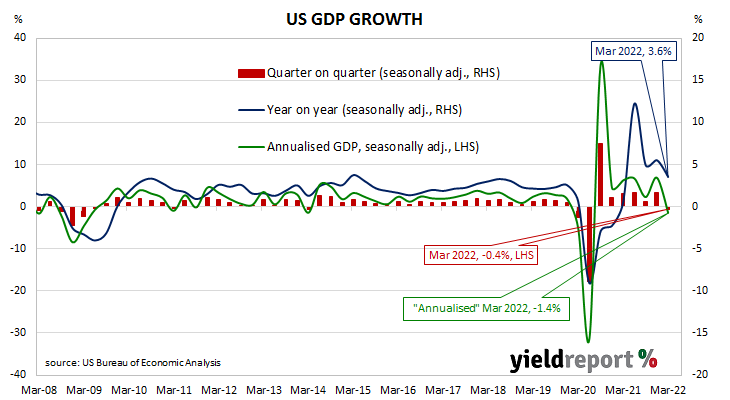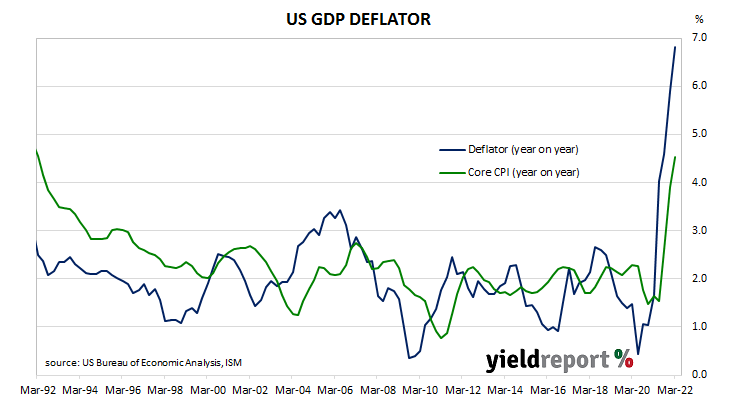Summary: US GDP down 0.4% (1.4% annualised) in March quarter; contrasts with 0.2% increase (1.0% annualised) expected; “some flattening” of growth, consumption; Import growth “phenomenally strong”, main drag on GDP; GDP price deflator annual rate rises from 5.9% to 6.8%.
US GDP growth slowed in the second quarter of 2019 before stabilising at about 0.5% per quarter. At the same time, US bond yields suggested future growth rates would be below trend. The US Fed agreed and it reduced its federal funds range three times in the second half of 2019. Pandemic restrictions in the June quarter of 2020 sent parts of the US economy into hibernation; the lifting of those same restrictions sparked a rapid recovery.
The US Bureau of Economic Analysis has now released March quarter “advance” GDP estimates and they indicate the US economy contracted by 0.4% or at an annualised rate of 1.4%. The figure contrasted with the 0.2% increase (+1.0% annualised) which had been generally expected as well as the December quarter’s 1.7% expansion after revisions.
“While there was certainly noise within the GDP figures and should be downplayed somewhat, it does suggest some flattening off of growth and consumption…” said NAB senior economist Tapas Strickland.
US GDP numbers are published in a manner which is different to most other countries; quarterly figures are compounded to give an annualised figure. In countries such as Australia and the UK, an annual figure is calculated by taking the latest number and comparing it with the figure from the same period in the previous year. The diagram above shows US GDP once it has been expressed in the normal manner, as well as the annualised figure.
US Treasury bond yields moved higher at the short end on the day but barely moved elsewhere along the curve. By the close of business, the 2-year Treasury bond yield had gained 4bps to 2.63%, the 10-year yield had returned to its starting point at 2.83% while the 30-year yield finished 1bp to 2.90%. In terms of US Fed policy, expectations for a higher federal funds rate over the next 12 months firmed. At the close of business, May contracts implied an effective federal funds rate of 0.775%, 44bps higher than the current spot rate. July contracts implied 1.475% while March 2023 futures contracts implied an effective federal funds rate of 2.975%, 264bps above the spot rate.
“Inventories and government spending need to normalise following the pandemic and supply chain disruption, so that volatility is understandable,” said ANZ Head of Australian Economics David Plank. “Import growth, however, is phenomenally strong and is the main drag on GDP. It argues strongly that the Fed needs to proceed with rate rises.”
One part of the report which is often overlooked are the figures regarding the GDP price deflator, which is another measure of inflation. The GDP price deflator is restricted to new, domestically-produced goods and services and it is not based on a fixed basket as is the case for the consumer price index (CPI). The annual rate rose from the December quarter’s revised figure of 5.9% to 6.8%.



